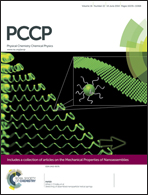Molecular structure and stability of dissolved lithium polysulfide species†
Abstract
The ability to predict the solubility and stability of lithium polysulfide is vital in realizing longer lasting lithium–sulfur batteries. Herein we report combined experimental and computational analyses to understand the dissolution mechanism of lithium polysulfide species in an aprotic solvent medium. Multinuclear NMR, variable temperature ESR and sulfur K-edge XAS analyses reveal that the lithium exchange between polysulfide species and solvent molecules constitutes the first step in the dissolution process. Lithium exchange leads to de-lithiated polysulfide ions (Sn2−) which subsequently form highly reactive free radicals through dissociation reaction (Sn2− → 2Sn/2˙−). The energy required for the dissociation and possible dimer formation reactions of the polysulfide species is analyzed using density functional theory (DFT) based calculations. Based on these findings, we discuss approaches to optimize the electrolyte in order to control the polysulfide solubility.


 Please wait while we load your content...
Please wait while we load your content...